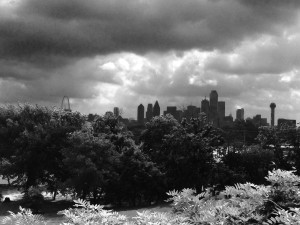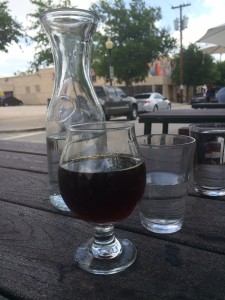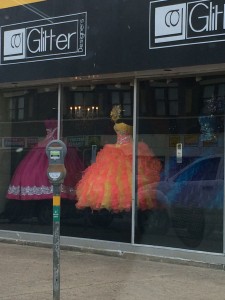My father’s house shines, hard and bright
It stands like a beacon, calling me in the night
Calling and calling, so cold and alone
Shining cross this dark hallway, where our sins lie unatoned.
“My Father’s House,” by Bruce Springsteen. All photos courtesy of The TexPat.
I sat today on a breezy, shaded patio overlooking a large, mixed-use development/construction site on what once were arid grasslands near one of the bridges that connects Oak Cliff to downtown Dallas. Glossy, glassy contemporary structures, promising sleek lofts and studios. Catty-corner to this construction site is a group of contemporary single-families with lengths of large floor-to-ceiling windows, cut off from the modest frame houses of its mostly Hispanic neighbors by physical barriers and a number of rather scary signs. The affluent pioneers craving a respite from sameness can do so with at least a little bit of shelter from the more “undesirable” aspects of their adventurous “new” neighborhoods. Gentrification.
Like native Brooklynites and Oaklanders, I of course have mixed feelings. Overall in the TexPatch, I have felt and expressed exuberance regarding the changes that have crossed the Trinity River and infiltrated the area in which I grew up. Oak Cliff was dry for a long time – not just “dry” in the alcohol-free sense (which it was), but also arid in its absence of quality services and amenities for its residents, which dissipated during the era of white flight, despite Oak Cliff’s still-sizable white population and solid tax base of hard-workers of varied ethnicities. Enter the new millennium, and not only have Caucasians and fresh produce returned to the ‘Cliff, we also have green markets and green juices. We have wine bars, brewpubs and sidewalk cafes in the Bishop Arts section serving a rainbow coalition of patrons that has expanded beyond the traditional Black/White/Mexican trifecta. Pho, curry and sushi spots sit alongside BBQ joints and taquerias. A new place specializes solely in hard cider. There are more newspaper boxes dedicated to Dallas’ LGBT weekly than the Dallas Morning News in some areas. There’s Yoga and Reiki. Indie bookstores and vinyl records. Today, a kind, bearded waiter in a straw fedora brought me a “black and blue nitrogenated cold coffee on tap” and a water dish for my dog on the patio of one of my favorite new cafes. As I sipped my newfangled coffee creation at one of the rustic-cool outdoor picnic tables, I spotted two Vespas and a charging station for electric cars in the adjacent parking lot.
There has always been a certain aspect of gentrification that has appealed to me and my middle class, wannabe-cool-and-comfortable-at-the-same-time-sensibilities. As a kid, my favorite Dallas neighborhood was Oak Lawn, on the northern border of downtown (as opposed to my Oak Cliff home, which flanks the south). North Dallas has always been “preferred” by most Dallasites, because of its wealth and homogeneity, but Oak Lawn was always a little different despite its prime location. There were artists and gay people and funky cottages-turned-cafes. In the more opulent sections of Oak Lawn, sleek, contemporary homes were constructed adjacent to stately Georgians and Tudors in a way that was harmonious, not hideous. Hippies slept on the rolling lawns of Lee Park overlooking Turtle Creek, mere steps from Dallas’ must luxurious high-rise residences. A theater designed by Frank Lloyd Wright overlooked the creek, hidden behind a thicket of evergreens. Oak Lawn was, and possibly still is, a microcosm of energy and diversity and culture and experiences that made a huge impression on me as a middle class kid in the middle of the country. What attracted me to Oak Lawn as a kid is what currently attracts me to New York and San Francisco and L.A. and the changes to certain sections of my hometown.
These days when I return home, I don’t have to head north to Oak Lawn or other areas of North Dallas for a taste of mosh or style. Or a non-wilted green vegetable. In Oak Cliff I can swaddle myself in the comfort and security of my family’s Leave it to Beaver, tv dinner lifestyle (if The Beav was Black and Female, that is), but in minutes enjoy cold brewed coffee on tap and catch a yoga class in Bishop Arts, followed by a leisurely cruise past some shelter magazine-worthy, midcentury modern home renovations in Kessler and Stevens Park on my way back to the crib.
Much of my family and many family friends reside about 10-15 minutes south or east of the funkiness of Bishop Arts and the relative affluence of Kessler Park and Stevens Park. My parents’ home sits among the leafy, quiet lanes just beyond the action, where brick ranches and ramblers spread long and low on freshly-mown lawns. Most are still well-maintained, at least on the exterior, though opening a door is a crap shoot. For Sale signs still abound, in spite of the economy’s rebound. Elderly residents move on or pass on, and are not quickly replaced with new families that bring energy and life to a neighborhood. One home on my mother’s street was torn down when the heirs either couldn’t or wouldn’t maintain it during the difficult years when no one could sell anything. The home of a gracious, and thankfully-nosy neighbor (her eagle eye on the block’s comings and goings was far more precise than any security system) who brought us a homemade bundt cake one Christmas appears occupied – an older model Chevy sits in the drive, a satellite dish is visible from the curb – but the sheets covering the once-lace-curtained windows call to question whether the new folks are neighbors or squatters. The types of squatters that burned down one of my parents’ investment properties after making off with all of the copper wiring and fixtures. I take refuge among the familiar furnishings and photos of my family home. But our routines and day-to-day lives are different. More cautious. And less conscientious. A layer of dust coats many of my memories.
My prior Oak Cliff home, where we lived in my younger years, is even harder to visit. Despite its proximity to a lovely golf course and public parks, what was once an aspirational subdivision for educated Black folks (who unintentionally drove out the less educated white folks that preceded them) is no longer so idyllic. Some of the old friends are still there, and their pride in their homes is still evident. But as we drove past our own prior home yesterday, my elderly mom shook her head and said “we used to take so much pride in where we lived.” The new windows, doors and other renovations detracted from the clean lines of our modest, GE home with its built-in appliances, picture windows and planters. Cars filled the narrow driveway, a satellite dish tacked onto the front of the house sullied the curb appeal, and menacing “Beware the Dog” signs were stuck all over the place. These observations are shallow and snobbish, but when a place where you lived and loved life changes for the worse, these emotions are human. Decay is harder to accept than decor, which is why gentrifiers have appeal, until you realize that they are pricing you out of the neighborhood you supported and stuck with during their prior periods of disdain and neglect of what they now covet.
Perhaps because the changes are close but concentrated, the gentrification of Oak Cliff has been easier to take. In fact it has been welcome, because of the added flavor options, and opportunities, in our backyard. The hipsters are here, and we are benefitting from what they have to offer and the offerings that follow them. But beyond Oak Cliff’s hot pockets, one is still hard-pressed to find a hardware store, clothing boutique, card store, ice cream parlor, butcher, bookstore or quality home furnishings outpost. There’s no Fedex Kinko’s I’m aware of, and our lone Starbucks (which was SO convenient to my parents’ place and even sported a drive-through!) closed a few years ago. Today I had to drive to Duncanville just to have some keys made. Big box stores like Home Depot and Target, and chain restaurants like Olive Garden and Chili’s skirt the southern perimeter of my southern neighborhood, since so many middle class Oak Cliffers saw fit to move to southern suburbs like Duncanville, DeSoto and Cedar Hill in the ’80s and ’90s. In between the ‘burbs and bohos, in the spaces where folks like my parents live, sit long stretches of tire stores, tax preparers, beauty supply spots, drive-through banks and fast food drive-throughs. So many tire stores and tax preparers that I wonder if Oak Cliff is an entire community of drag-racing sole proprietors that can’t figure out the tax code. And as a hallmark of both our normalness and fabulousness, within walking distance of Bishop Arts’ hipsters is a string of far-out and fabulous quinceanera dress shops.
Now I’ll move beyond my Oak Cliff home and back to the question of what’s up with that general “Texas thing” that has become a running narrative for me and has morphed into The TexPatch. For better or worse, home defines us, even when we break from it, reject it, move on from it. Thoreau’s Walden, Faulkner’s Mississippi, Wharton’s privileged Northeastern society, Achebe’s Nigeria – though our homes do not control or limit us, our homes still influence us and the stories we choose to tell, personal and fictional, whether we like it or not. Texans are prone to infatuation about our Texan-ness, and I am no exception, particularly in this reflective stage in my life in which I am sharing my voice, vision and opinions with the world. The TexPat absorbs it all and abides, albeit in my own way.
The proximity to my childhood home and really good margaritas ensures more wandering, rambling reflections to come.





 Follow
Follow


